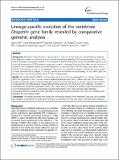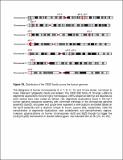Por favor, use este identificador para citar o enlazar a este item:
http://hdl.handle.net/10261/39450COMPARTIR / EXPORTAR:
 SHARE SHARE
 CORE
BASE CORE
BASE
|
|
| Visualizar otros formatos: MARC | Dublin Core | RDF | ORE | MODS | METS | DIDL | DATACITE | |

| Título: | Lineage-specific evolution of the vertebrate Otopetrin gene family revealed by comparative genomic analyses |
Autor: | Hurle, Belen; Marqués-Bonet, Tomàs CSIC ORCID ; Antonacci, Francesca; Hughes, Inna; Ryan, Joseph F.; Eichler, Evan E.; Ornitz, David M.; Green, Eric D. | Fecha de publicación: | 24-ene-2011 | Editor: | BioMed Central | Citación: | BMC Evolutionary Biology 11(1): 23-40 (2011) | Resumen: | [Background]: Mutations in the Otopetrin 1 gene (Otop1) in mice and fish produce an unusual bilateral vestibular pathology that involves the absence of otoconia without hearing impairment. The encoded protein, Otop1, is the only functionally characterized member of the Otopetrin Domain Protein (ODP) family; the extended sequence and structural preservation of ODP proteins in metazoans suggest a conserved functional role. Here, we use the tools of sequence- and cytogenetic-based comparative genomics to study the Otop1 and the Otop2-Otop3 genes and to establish their genomic context in 25 vertebrates. We extend our evolutionary study to include the gene mutated in Usher syndrome (USH) subtype 1G (Ush1g), both because of the head-to-tail clustering of Ush1g with Otop2 and because Otop1 and Ush1g mutations result in inner ear phenotypes. [Results]: We established that OTOP1 is the boundary gene of an inversion polymorphism on human chromosome 4p16 that originated in the common human-chimpanzee lineage more than 6 million years ago. Other lineagespecific evolutionary events included a three-fold expansion of the Otop genes in Xenopus tropicalis and of Ush1g in teleostei fish. The tight physical linkage between Otop2 and Ush1g is conserved in all vertebrates. To further understand the functional organization of the Ushg1-Otop2 locus, we deduced a putative map of binding sites for CCCTC-binding factor (CTCF), a mammalian insulator transcription factor, from genome-wide chromatin immunoprecipitation-sequencing (ChIP-seq) data in mouse and human embryonic stem (ES) cells combined with detection of CTCF-binding motifs. [Conclusions]: The results presented here clarify the evolutionary history of the vertebrate Otop and Ush1g families, and establish a framework for studying the possible interaction(s) of Ush1g and Otop in developmental pathways. |
Descripción: | Grupo de trabajo: NISC Comparative Sequencing Program. -- 18 páginas, 6 figuras, 2 tablas. | Versión del editor: | http://dx.doi.org/10.1186/1471-2148-11-23 | URI: | http://hdl.handle.net/10261/39450 | DOI: | 10.1186/1471-2148-11-23 | ISSN: | 1471-2148 |
| Aparece en las colecciones: | (IBE) Artículos |
Ficheros en este ítem:
| Fichero | Descripción | Tamaño | Formato | |
|---|---|---|---|---|
| 1471-2148-11-23.xml | 156,35 kB | XML | Visualizar/Abrir | |
| 1471-2148-11-23.pdf | 1,15 MB | Adobe PDF |  Visualizar/Abrir | |
| 1471-2148-11-23-S6.PDF | 194,28 kB | Adobe PDF |  Visualizar/Abrir | |
| 1471-2148-11-23-S13.TXT | 3,81 kB | Text | Visualizar/Abrir | |
| 1471-2148-11-23-S9.TXT | 588 B | Text | Visualizar/Abrir | |
| 1471-2148-11-23-S5.PDF | 286,47 kB | Adobe PDF |  Visualizar/Abrir | |
| 1471-2148-11-23-S8.TXT | 594 B | Text | Visualizar/Abrir | |
| 1471-2148-11-23-S4.DOC | 45,5 kB | Microsoft Word | Visualizar/Abrir | |
| 1471-2148-11-23-S10.TXT | 581 B | Text | Visualizar/Abrir | |
| 1471-2148-11-23-S2.XLSX | 49,99 kB | Microsoft Excel XML | Visualizar/Abrir | |
| 1471-2148-11-23-S3.PDF | 337,75 kB | Adobe PDF |  Visualizar/Abrir | |
| 1471-2148-11-23-S7.TXT | 579 B | Text | Visualizar/Abrir | |
| 1471-2148-11-23-S11.TXT | 349 B | Text | Visualizar/Abrir | |
| 1471-2148-11-23-S12.PDF | 399,98 kB | Adobe PDF |  Visualizar/Abrir | |
| 1471-2148-11-23-S1.TXT | 642 B | Text | Visualizar/Abrir |
CORE Recommender
PubMed Central
Citations
12
checked on 17-abr-2024
SCOPUSTM
Citations
13
checked on 20-abr-2024
WEB OF SCIENCETM
Citations
13
checked on 29-feb-2024
Page view(s)
318
checked on 21-abr-2024
Download(s)
1.024
checked on 21-abr-2024
Google ScholarTM
Check
Altmetric
Altmetric
Artículos relacionados:
NOTA: Los ítems de Digital.CSIC están protegidos por copyright, con todos los derechos reservados, a menos que se indique lo contrario.
